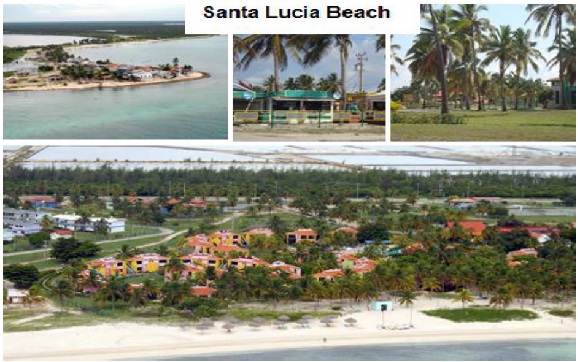
Figure No 1: Santa Lucia Beach, municipality Nuevitas, Camagüey
Source: Ministry of economy and planning, 2015
Procedure for the Diagnosis of the Intersector Relationships in the Patter of Municipal Development
(*) Concepción de la Torre Rodríguez; (**) Santos Pineda Zamora; (***) José Luis Céspedes Cansino
(*) Faculty of Agricultural Sciences
University of Camagüey Ignacio Agramonte Loynaz, Camagüey, Cuba
conchy.delatorre@reduc.edu.cu
(**) Economy Faculty
University of Camagüey Ignacio Agramonte Loynaz, Camagüey, Cuba
santos.pineda@reduc.edu.cu
(***) Faculty of Agricultural Sciences
University of Camagüey Ignacio Agramonte
Loynaz, Camagüey, Cuba
jose.cespedes@reduc.edu.cu
Reception Date: 01/11/2017 - Approval Date: 25/01/2018
ABSTRACT
In this investigation, a diagnosis of the intersector relationships in the system of strategic administration of the municipality of Nuevitas, Camagüey, was carried out and the problem, that the connections that must exist between the different sectors of the economy are not planned, was raised. The objective of this study is to design a procedure that allows the diagnosis of the intersector relationships for the achievement of the mutual dependence between variables and factors of the development strategies. The methods that were used are: Analysis, Synthesis, the systemic, interviews, surveys, and the documental analysis. It was proven in the diagnosis that the intersector relationships analysis was not introduced. It is influenced by the deficiencies that exist in the methodology design for the situational strategic diagnosis. According to the results obtained, shortcomings were identified in terms of the status of the relationships in the selected entities, as well as the companies that showed default in the main indicators showing poor coordination, evidencing the weaknesses and threats, strengths and opportunities in the municipality, that it makes necessary to elaborated in the diagnosis the problem that affects the intersector relationships. The procedure has as main assumptions that the diagnoses should establish methods to include the analysis of the horizontal relationships among the different sectors, to achieve a greater efficiency in the comprehensive development programs.
KEY WORDS: Intersector Relationships; Strategic Diagnosis; Integral Development; Local Development.
INTRODUCTION
The processes of local development management have been taking, for some years now, an increasingly relevant role in achieving higher levels of welfare and progress for society and for localities in a particular way. On the other hand, the Guidelines of the Economic and Social Policy, aim to offer localities a greater role in these management processes. Being necessary that the planning has a strategic character, what is justified by the very essence of the strategic approach in the management systems.
The need for this approach is reinforced if we take into account that the Cuban municipality is immersed in a process of updating its management model, in which the demands of the changes that occur require a high capacity to adapt to those changes. In the strategic planning system, the definition of the strategy is considered as a hypothesis that is constantly validated in practice and that poses by definition, basically a chain of cause - effect relationships, that when coordinated in the management process, they enable the achievement of the objective that gave rise to it (Kaplan, R. and Norton, D; 2000).
The planning will cover the state business system, the budgeted activity, the international economic associations, it will regulate other forms of non-state management that are applied and will be perfected and will be more objective at the different levels. This improvement is based on the definition of a methodology to implement what has been called the Integral Development Program of the municipalities.
This program and its methodology, constitute a remarkable instrument for the planning of the development in the localities, nevertheless the scene that finds the efforts to unchain this type of planning, is characterized by the existence of numerous elements of the planning that follow the vertical orientation - Sectorial of the economy, which makes them mechanisms that require sectorial management that, when settling in the municipalities, makes it difficult to implement inter-sectorial horizontal relationships that materialize in each municipality, which makes these plans mechanisms that present many difficulties when inducing the aforementioned horizontal relationships (González, R. 2015).
Inter-sectorial relations in Latin American countries, such as the case of the Mexican economy are formed by the set of economic activities that lead to the production of goods and services and is divided into three economic sectors, which in turn are composed of several branches productive.
Agricultural sector (primary sector): It is formed by four branches: Agriculture, Forestry, Livestock and fishing.
Industrial Sector (secondary sector): The extractive industry and the manufacturing industry.
Social Sectors: It is important to point out that social sector (social agents) participate or intervene in the economy of the country; that is, social groups, formed by people who contribute their work and capital to the movement of the entire economic system. Between these three sectors, economic relations called inter-sectorial relations are established.
Taking into consideration an analysis of the predominant local development factors in the municipality (De Dios, A. and González, O. 2015), the vision of a set of strategic territorial objectives can be operationalized.
All of the above provoke the need to plan also the links that, over time, should exist between the different sectors of the economy. When this problem arises, there is a need to also refine the methodologies in what it infers, to the diagnoses that are executed, without taking into account the territorial ordering. The dynamics of the diagnosis should allow the definition of the factors that strategically will define what are the purposes that the territory should be drawn for each of the current annual periods (Almaguer, D. 2014).
This diagnosis evidently is insufficient for the different sectorial interests, for two fundamental aspects: first, because its participatory character is limited. The second and another limiting aspect is related to the limited strategic approach, since it does not consider the external environment in all its dimensions. It is for all of the above that the integral development program without the application of a strategic approach causes that the starting point of the entire medium-term strategy does not conceive the system of horizontal cross-sectorial relationships that occur in the dynamics of the territory. (González, R. 2015).
So the scientific problem that arises can be stated through the following scientific question: How to ensure that the strategic diagnosis of the territory reflects the starting point of the system of inter sectorial relations that occur between the main sectors of the municipality?
From which the following hypothesis can be based: if an instrument is elaborated that is incorporated into the methodology of elaboration of the strategic territorial diagnoses that provide an analysis of the existing inter sectorial relations, it will be possible to establish the state that this system of relations has cross-sectorial.
Objective: To design a procedure that allows the situational diagnosis of the inter sectorial relations, for the achievement of the mutual dependence between variables and factors of the development strategies, that allow their convergence.
Object of research: The strategic management system of the municipality.
Field of action: Inter-sectorial relations in the municipal development strategy.
Impact: Provides managers with a procedure that facilitates the establishment of ways for the convergence between municipal development strategies and sector development strategies, thus achieving the management of the municipality's comprehensive development program.
DEVELOPMENT
Materials and methods
To carry out the research tasks, theoretical and empirical methods were used. The use of these methods and techniques made it possible to study the corresponding object and field of action in their relations with other objects, phenomena and processes of nature, society and thought. It also made it possible to determine the contradictory relationships that occur in the planning process in the territory and that constitute its source of development.
Within the theoretical methods were used: The methods of analysis and synthesis.
Historical - logical: in the chronological study of the research object, its evolution and development.
Dialectical method: to specify the character of the contradictions that underlie.
Systemic method: to conceive the nature of the interactions in the dynamic relationships between its components.
Within the empirical methods were used, interviews, surveys, observation, and documentary analysis, which made it possible to characterize the current situation of the object of study and the field of action.
Results and Discussion
The municipality of Nuevitas of Camagüey province was taken as reference, located 3 km from Punta del Guincho, located in the northeast portion of the province, with an extension of 1372.32 km², a land area of 1, 119.16 Km² and of adjacent places of 253.16 Km².
Geographical limits: To the north old canal of Bahamas, to the south the municipality of Guaimaro, to the east municipality Manatí province of Las Tunas and to the west municipality Minas.
Currently its development is identified by industry, agriculture and tourism reaching the category of agro-industrial and tourist city, among the few in the country. It reaches a population of 61,625 inhabitants, with an urban population of 47,517 and a rural population of 14,108.
Diagnostic results
Situational diagnostic
Economic structure
Nuevitas, is an agro-industrial municipality, the fundamental sectors are: Industry, Tourism and Agriculture, which has had a new dynamic with the Administrative Policy Division that incorporates the area of Camalote and San Miguel.
These are the basic sectors of the economy of the municipality that represent 66.5% of the Added Value and 84% of the Commercial Production.
Agricultural activity
The municipality has a municipal delegation of agriculture and the following entities: Flora and Fauna, Stockpiling, Forestry, Refrigerator, Santa Isabel Swine Integral Unit, Agricultural Company and Apiculture Company.
Land use in agricultural activity
The municipality has a total area of 138,105.24 hectares, of which, the mainland: 91981.46 ha with different productive purposes.
The agricultural area is 49444.58 hectares, representing 36% of the total territory and dedicated to livestock 43137.43ha, several crops 6307.15 ha, temporary crops 4373.6 ha and permanent crops 1933.55 ha.
Industrial activity
The polar characterization of the pole is oriented towards chemistry, metal, mechanics, electrical generation, construction materials and port activity as fundamental and the small-scale food industry.
Recreation and tourism activity
At present, the Santa Lucia hotel facility is represented by four hotels belonging to the CUBANACÁN chain.
The tourism sector is made up of the Provincial Delegation of MINTUR (Ministry of Tourism), with the IslAzul Chain and the Cubanacan Chain.
The IslAzul Chain serves the Costa Blanca Tararaco Hotel and the Santa Lucia Caonaba Complex.
Among the entity of the tourism that supports this activity stand out: Palmares, Caracol, Servisa, Emprestur, ITH marketer, Cubatur, Formatur, Turempleo and Fintur.
Recreational tourism activity takes place in the three areas under study, taking into account the nature tourism routes that are destined for Playa Bonita, located in Cayo Sabinal and Ballenato del Medio Cay in the Bay. Tourism is developed potentially in the area of Santa Lucia recognized as the most important tourist pole of the province.

Figure No 1: Santa Lucia Beach, municipality Nuevitas, Camagüey
Source: Ministry of economy and planning, 2015
Participatory Diagnosis
A community diagnosis of participatory nature was made by the communities, yielding a set of problems that have a municipal significance and constitute aspects that should receive priority attention in the planning horizon.
Insufficient food self-sufficiency.
Shortage of construction materials projects.
Deterioration of the housing fund or others.
Deterioration of some houses and streets.
Problems with water supply.
Organizational diagnosis
The results of the organizational participatory diagnosis will be part of the project bank of the Local Development Local Initiative.
The following needs are summarized below:
1-Minindustries for the processing of agricultural products.
2-An ice plant for platform fishing.
3-The processing of the production of small livestock.
Municipal Strategic Diagnosis
According to the results of the diagnostic stages, a summary of the potentialities and restrictions of the municipality is presented. Table No 1
SWOT analysis: (Weaknesses, threats, strengths and opportunities)
Once the main potentialities and restrictions are known, a qualitative analysis is carried out, identifying the following: Weaknesses, Strengths, Threats and Opportunities of the territorial strategic system, which allows applying the SWOT analysis to deepen the relevant aspects of the interactions between these strategic factors and that integrate, the sectoral-vertical approach that traditionally have with the territorial-horizontal approach, which raises the management system of the municipal development strategy.
After a concretion process, it was possible to reduce the list to variables or key factors for each of the Weaknesses, Threats, Strengths and Opportunities, so that attention could be given to the key aspects of development.
Table N ° 1. SWOT analysis
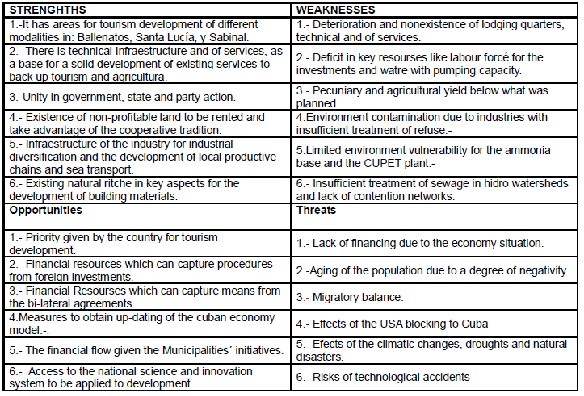
Sourse: Pineda, S. y De la Torre C. 2015
Instrument to improve the situational diagnosis of the municipality, to describe the inter-sectorial relations
The starting point of the analysis is derived from the regulations that allow us to calculate the level of activity of the sector that will function as the pivot of development of the municipality in the period of the planning horizon. This was done by applying a diagnostic mechanism from the starting point, to form the relationship system and be able to systematically verify the progress of the investments in an integral manner.
In the proposed instrument to specify the current situation of the municipality was taken into account:
Analysis of the municipality development model to diagnose inter-sectorial relations, and detailed analysis of the synthesis of the Municipal Strategic Diagnosis. In the analysis of the municipality's development model it was shown that it is necessary to increase the use of local local development initiatives, the management of new development projects, the training of a new qualified work force, and the expansion of market studies.
Table N° 2. Procedures to diagnose intersectorial relationships
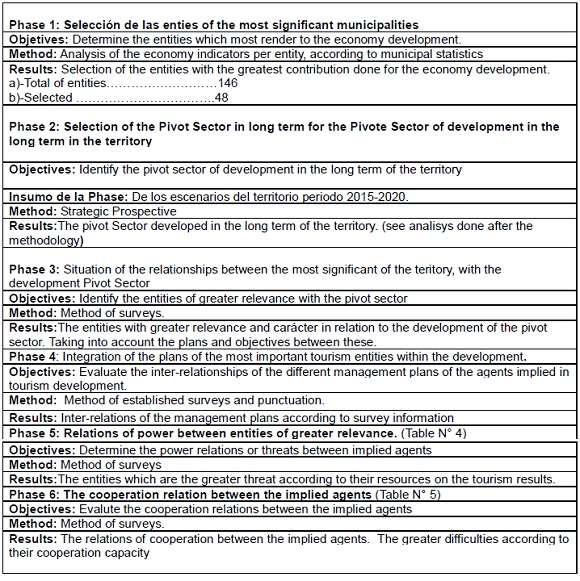
Sourse: Own Elaboboration
Phase 1 Selection of the Most Significant Municipality Entities
Classification according to the different sectors of the economy, of the 146 entities that exist in the municipality.
The behavior of economic analysis indicators at the end of the year, commercial production, gross added value, and consumption of materials. (Selection of the 48 entities that have the greatest contribution to economic development in the Municipality).
Phase 2 Sector Selection Pivot long-term development of the territory
Analysis carried out according to scenarios of the municipality Nuevitas in the period 2015-2020. Bibliographic reference. (Cárdenas, M. 2015)
a) -Selection of the factors of change. Indicated in the results of the Strategic Diagnosis.
Table No. 3. Factors of change
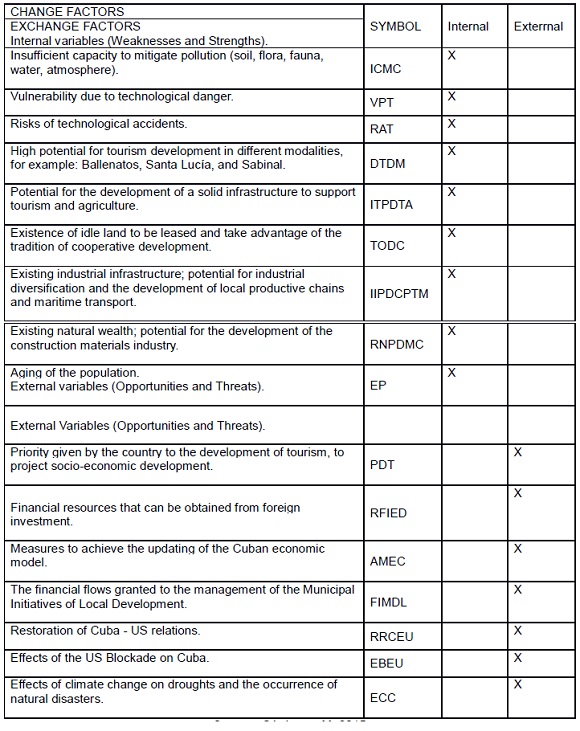
Source: Cárdenas, M. 2015
b) -Determination of the interrelations of the factors of change of the selected territorial system.
Next, the most selected motor and dependent factors, located in the second quadrant, are listed. They are illustrated in (Figure No. .2 / Plane motor-dependence).
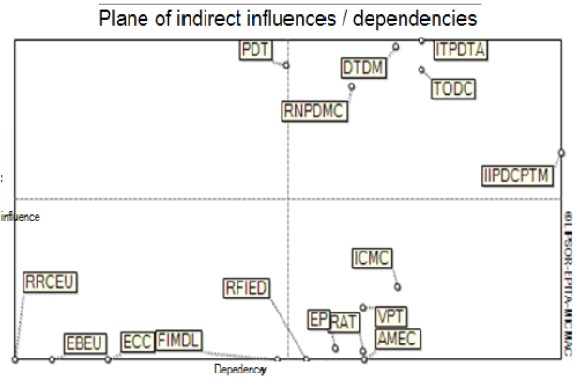
Figure No. 2 Motor plane / dependence
Source: Cárdenas, M. 2015
C) - Derived from the ratio of maximum motility factors
The results of the stakeholder analysis revealed that 90% of the experts agree that:
- The most dynamic and influential sector on the rest, is the Tourism Sector (Results phase 2)
- The variables that establish greater relationships of current and potential indirect influences are: DTDM, IIPDCPTM, PDT, ITPDTA, TODC.
They are maintained in the second quadrant after analyzing the plane of displacements: direct / indirect; which shows that they are variables both very motor and simultaneously very dependent.
Phase 3:
Situation of the inter-sectorial relations between the entities of the territory with the pivotal sector of development.
The situation reflected by the diagnosis shows a lack of resources to face the development plan for the coming years, which constitutes an element of analysis. For such purposes, an examination of the current situation of the inter-sectorial relations in the development strategy was made, so that different results and observations are obtained, taking into account the Investment Plan to be executed in the Cayería Norte, as well as the different companies that have deficiencies in the main indicators and production needs for 2020.
As results of the surveys conducted according to the procedure, the following are obtained, in relation to the situation of inter-sectorial relations in the municipality:
That the group of entities of greater relevance in the tourist development, make up: the MINTUR, MINAGRI, Hydraulic Rss, Electric Company, Fishing, Construction, Services, and Transportation. Of which it is distinguished, the interrelation that must exist between the different entities, to carry out the fulfillment of the development plans in the municipality.
Phase 4: Integration of the plans in the most relevant entities.
The management plans of the different entities and those subordinated to them were characterized to determine the integration of the plans in the tourism entities and companies.
Phase 5: Power relations between the most relevant entities.
It is linked to this result, the power relations between the agents involved, Table N ° 4, to determine that these companies have threat capabilities over said entities, according to the resources they have, influencing their relations, the MINAGRI entities, the Fishing, Construction and services, fundamentally.
Phase 6:
The determination of cooperative relations between the agents involved is added to this analysis. Table No. 5. Resulting from the analysis of these relationships, that the entities with greater difficulties coincide with those indicated above.
Table No. 4. Power relations and coordination among the agents involved
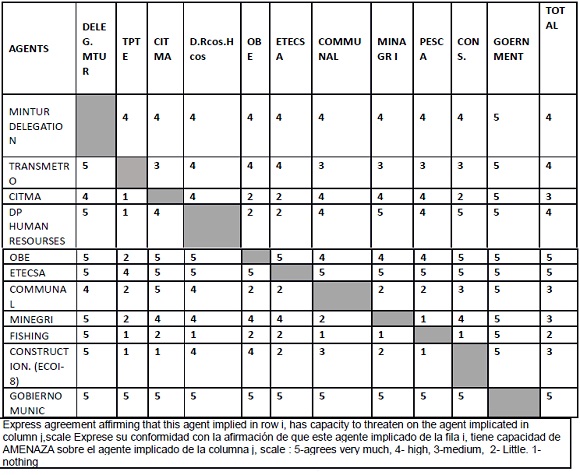
Sourse: Own elaboration
Table N° 5. Cooperation relations between implied agents-
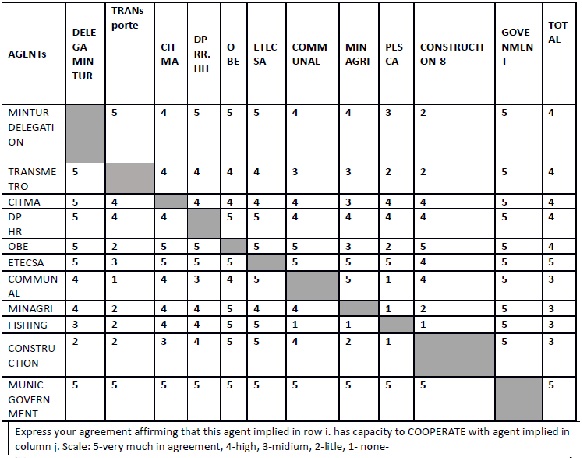
Sourse: Own elaboration
Analysis carried out on the subjacent actors, (Sectors and enterprises).
Table N° 6. Relations between key factors and subjacent
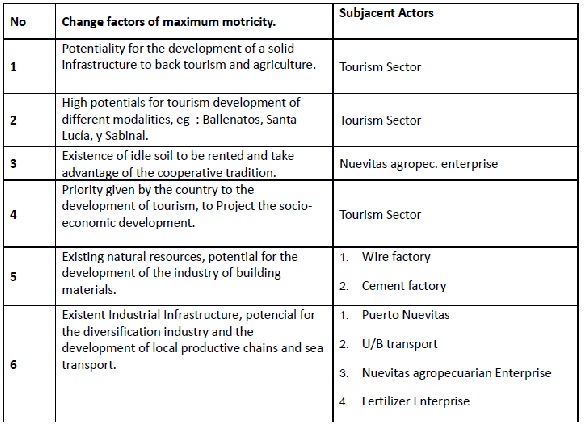
Sourse: Cárdenas, M. 2015
Most dynamic actors in the territory in the medium term:
1. Tourism sector.
2. Nuevitas Agro Enterprise
3. Nuevitas Port.
4. ECOI 8. Construction.
Throughout the period, priority is given to the development of tourism in the northern keys of the municipality, which is combined with the gradual realization of foreign investment processes that offer security to the process of expanding the hotel plant and infrastructural investments for the development of the support activity (roads, connectivity, electricity, drinking water supply) and cruise tourism; agricultural development and industrial diversification.
All this allows the hotel plant to be gradually increased in the two tourist poles of the municipality: Santa Lucia and Sabinal, until completing the construction of new rooms until 2020. Soon the cruise activity in the port will begin. Nuevitas to Santa Lucia and city tourism will be strengthened.
The analysis made it possible to identify as variables of greater power: 1) the development of tourism activity, 2) the development of agricultural activity, 3) industrial diversification; 4) port development and 5) the development of productive infrastructure and services, to ensure tourism, industrial and agricultural development, as well as contributing to the solution of environmental problems and social and community development.
CONCLUSION
A procedure was designed that allows the Strategic Situational Diagnosis of the inter-sectorial relations for the achievement of the mutual dependence between variables and factors of the development strategies, which admit their convergence, for which the state of the inter-sectorial relations system could be established, as well as the entities that present noncompliance in their fundamental indicators. Its influence in the management of the development plans and the threats of the result among them, as well as the relations of cooperation between the entities or agents involved in the development of the tourism sector, defined as Pivot Development Sector. This process notably complements the development strategy and its management system.
BIBLIOGRAPHCIAL ABSTRACT
Please refer to articles Spanish Biographical abstract.
REFERENCES
Please refer to articles in Spanish Bibliography.